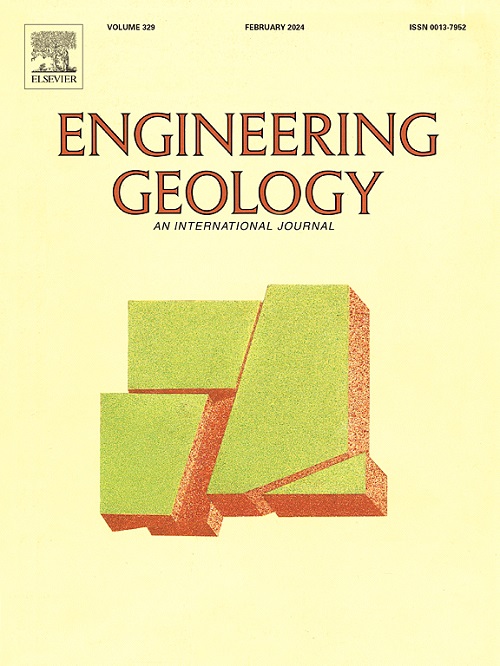冻融过程中土壤孔隙结构和水热变化的动态特性
IF 8.4
1区 工程技术
Q1 ENGINEERING, GEOLOGICAL
引用次数: 0
摘要
寒冷地区的冻融过程会改变土壤孔隙结构和性质,从而引发工程地质问题。土壤孔隙至关重要,但有关其变化和冻融影响的研究却十分有限。本研究利用磁共振成像--低温土壤水分分析仪(MRI-CSMA)探究饱和黄土在冻融过程中的孔隙结构、水分和温度变化,并利用扫描电子显微镜(SEM)比较冻融前后的变化。结果表明,在冻融过程中,土样冻结区的温度呈现出快速冷却、过渡冷却和低温稳定的阶段性变化,而未冻结区的温度下降则没有明显的阶段性变化。冻融作用对冻结区的大孔隙和中孔隙有明显影响,大孔隙平均增加 15%,中孔隙平均减少 16%,微孔变化很小(约增加 1%)。在未冻结区,微孔和中孔略有增加(分别为 2% 和 3%),大孔减少了 4%。此外,在冻结过程中,未冻结区的大孔逐渐减少,而中孔和微孔增加,导致土壤结构致密化,并促进水分向冻结前沿迁移。这导致冻结初期冻结前沿附近的含水量先增加后减少,证实了孔隙结构压缩在土壤冻结初期推动水分迁移的观点。这项研究为解决寒冷地区冻融条件下的工程地质问题提供了重要启示。本文章由计算机程序翻译,如有差异,请以英文原文为准。
Dynamic characteristics of soil pore structure and water-heat variations during freeze-thaw process
Freeze-thaw processes in cold regions alter soil pore structure and properties, leading to engineering geological issues. Soil pores are crucial, but research on their changes and freeze-thaw impacts is limited. This study used MRI-Cryogenic Soil Moisture Analyzer (MRI-CSMA) to explore pore structure, water, and temperature changes in saturated loess during freeze-thaw, and Scanning Electron Microscopy (SEM) to compare changes before and after. The results indicate that during the freezing process, the temperature in the frozen zone of the soil sample exhibited a staged change characterized by rapid cooling, transitional cooling, and stabilization at low temperatures, while the temperature decrease in the unfrozen zone showed no significant stages. Freeze-thaw action significantly affected the macropores and mesopores in the frozen zone, with an average increase of 15 % in macropores, a decrease of 16 % in mesopores, and minimal change in micropores (about a 1 % increase). In the unfrozen zone, there was a slight increase in micropores and mesopores (2 % and 3 %, respectively), and a 4 % decrease in macropores. Furthermore, during the freezing process, macropores in the unfrozen zone gradually decreased, while mesopores and micropores increased, leading to soil structure densification and promoting water migration towards the freezing front. This resulted in an initial increase followed by a decrease in water content near the freezing front during the early stages of freezing, confirming the view that pore structure compression drives water migration in the early stages of soil freezing. This study provides important insights for addressing engineering geological issues in cold regions under freeze-thaw conditions.
求助全文
通过发布文献求助,成功后即可免费获取论文全文。
去求助
来源期刊

Engineering Geology
地学-地球科学综合
CiteScore
13.70
自引率
12.20%
发文量
327
审稿时长
5.6 months
期刊介绍:
Engineering Geology, an international interdisciplinary journal, serves as a bridge between earth sciences and engineering, focusing on geological and geotechnical engineering. It welcomes studies with relevance to engineering, environmental concerns, and safety, catering to engineering geologists with backgrounds in geology or civil/mining engineering. Topics include applied geomorphology, structural geology, geophysics, geochemistry, environmental geology, hydrogeology, land use planning, natural hazards, remote sensing, soil and rock mechanics, and applied geotechnical engineering. The journal provides a platform for research at the intersection of geology and engineering disciplines.
 求助内容:
求助内容: 应助结果提醒方式:
应助结果提醒方式:


